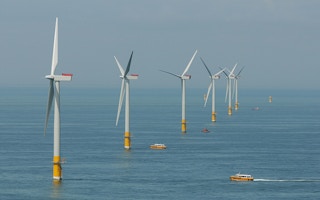Varying wind patterns caused by climate change could affect the cost of UK wind power, with northern Britain paying less than the south, a research paper suggests.
A simulation of changing wind resources by 2100 has found that the UK’s capacity for generating wind power will become more changeable, with some regions benefitting and others losing out. The year-on-year variation of wind power capacity will increase, the authors say.
The paper looked at what climate change will do to wind energy’s levelled cost of electricity (LCOE), the average value of one unit of power over the whole lifespan of the power source.
Across the UK, this cost is affected by the physical environment around the turbines and its impact on wind patterns, explains Iain Staffell, a researcher at the Centre for Environmental Policy at Imperial College London and co-author of the paper.
“
Companies are still finding their feet with how to analyse the impacts that climate change may have.
Iain Staffell, researcher, Centre for Environmental Policy
“An example would be the vegetation cover and topography, which affect how wind speeds change with height above ground,” he says. “Rougher surfaces create more drag, lower wind speeds and thus result in a higher cost.”
Policy implications
The researchers combined climate data sets to model changes in ground cover and what this would do to wind speed and availability in the UK. The simulation used by the researchers showed that LCOE is likely to rise in Wales and most of England, while it could fall in Scotland and over the North Sea.
The authors say climate change’s impact on wind patterns should inform government policy on renewable energy.
For example, investors could be asked to provide better climate change adaptation plans for planned facilities under the Strategic Environmental Assessment framework or the environmental impact assessment for infrastructure.
“Companies are still finding their feet with how to analyse the impacts that climate change may have,” says Staffell.
The issue of greater variation in wind is also important, as it could have an impact on the cost of electricity produced by wind farms. Onshore wind farms in Britain run at an average of 26 per cent of their full capacity, but this rises to 36 per cent at offshore plants.
In 2013 the government put in place so-called strike prices for electricity, in order to protect consumers from sudden price hikes.
This system – under which the government refunds power producers if market prices are below the strike price, but forces them to pay the balance if their energy is more expensive – might have to be revised under greater wind variation.
Staffell says that, if the LCOE increases, investing in wind farms could become less economically attractive. However, “the reverse is also true if costs decrease and investment increases,” he adds.
The results, published in the journal Renewable Energy, are from a single run of the model, and the researchers are keen to do a more in-depth study before making further policy recommendations.
They also say that choosing the right site for wind power remains paramount, as the impact of climate change on turbine efficiency is still less than the impact of a bad site decision.
Meanwhile they suggest looking at the energy grid to ensure that power can be easily transferred from the best wind power locations to where it is most needed.
Staffell highlights the “spatial mismatch” of the national grid, which is at its most developed in the large population centres of south-east Britain.
“[But] the greatest wind resource is generally found offshore and the further north and west you go,” he says.
This story was published with permission from Climate News Network.










